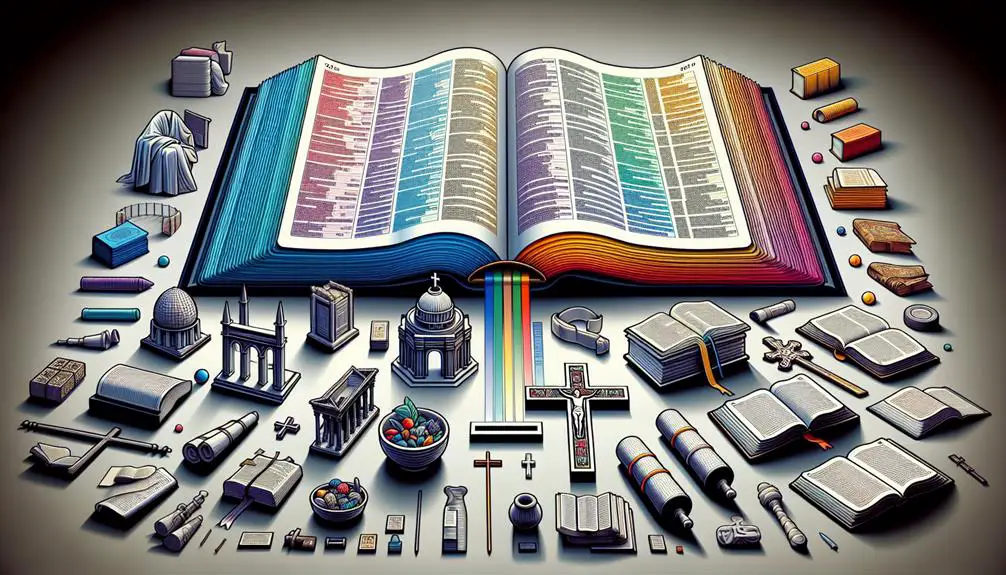This guide explores whether reading the Bible in order is the key to unlocking its deepest spiritual insights, or if another path awaits.

Are You Supposed to Read the Bible in Order
Navigating the Bible isn't a walk in the park; it's more akin to embarking on a vast, spiritual journey that begs the question: should you traverse its paths in the order laid out before you?
You've likely heard diverse opinions on whether to tackle it cover to cover or adopt a thematic, historical, or even a chronological approach. Each strategy has its pros and cons, shaping not just your understanding but your connection to the text.
As you ponder the best route for your spiritual exploration, consider how personalizing your journey could unveil insights in ways you've never imagined. What lies ahead might just transform your reading experience into a profound personal revelation.
Key Takeaways
- Reading the Bible in order is not mandatory; thematic, chronological, and historical approaches offer valuable insights.
- Sequential reading may miss thematic connections across books, potentially hindering a comprehensive understanding.
- A chronological strategy enhances the narrative's coherence and helps clarify the development of key themes.
- Diverse reading strategies, including thematic and historical, can deepen connections to the text and foster a more nuanced comprehension.
Understanding the Bible's Structure

To truly grasp the essence of the Bible, it's crucial to first understand its complex structure, which is organized into two main segments: the Old Testament and the New Testament. This foundational knowledge not only aids in comprehending the text's overarching narrative but also in recognizing its profound intricacies. You'll find that engaging with translation guides and delving into the cultural context of the periods in which the Bible was written are indispensable practices for any serious reader.
Translation guides are particularly vital because they offer insights into the nuances of the original Hebrew, Aramaic, and Greek texts. These guides can elucidate subtle meanings and interpretations that mightn't be immediately apparent, allowing you to connect more deeply with the material. They serve as a bridge, helping you navigate the linguistic and theological complexities inherent in such an ancient, sacred document.
Equally important is the exploration of cultural context. Understanding the historical, social, and political landscapes of the times in which the Bible's books were written sheds light on the motivations and circumstances surrounding its various writings. This knowledge equips you with the ability to discern the nuances of parables, commandments, and narratives, which were deeply rooted in the everyday lives and existential realities of ancient peoples.
Historical Reading Approach

After understanding the Bible's structure and the importance of translation guides and cultural context, you'll find that adopting a historical reading approach enhances your comprehension by situating the texts within their specific temporal frameworks. This method involves delving into the period in which each book was written, considering the historical events and societal norms of the time. It's not just about recognizing the sequence of events but also appreciating the cultural context in which these narratives were set.
By engaging with the Bible historically, you're not merely reading stories; you're immersing yourself in the living conditions, political climates, and social dynamics that shaped these narratives. Archaeological insights play a crucial role in this process, offering tangible evidence that brings biblical history to life. Through artifacts, inscriptions, and ruins, archaeology corroborates and elucidates the cultural context of biblical texts, providing a richer understanding of the settings and characters within.
This approach does more than enhance comprehension; it deepens your connection to the text. Understanding the historical backdrop allows you to grasp the significance of certain actions, rituals, and teachings in their original context, which may differ vastly from modern interpretations. It's a journey through time that reveals the Bible's texts as dynamic reflections of human history, shaped by and shaping the cultures in which they were born.
Incorporating a historical reading approach, then, isn't just about mapping biblical events on a timeline but about embedding yourself in the cultural and archaeological realities of the era. This enriched perspective fosters a more nuanced and profound appreciation of the Bible's teachings and stories.
Thematic Reading Approach

Exploring the Bible through a thematic reading approach allows you to uncover the overarching themes and motifs that weave throughout the diverse books, offering insights into the universal truths and moral lessons embedded within its pages. This method focuses not on the chronological order of the text but on genre exploration and understanding the cultural context of the narratives and teachings. It encourages you to connect dots across different parts of the Bible, enriching your comprehension and appreciation of its messages.
Theme |
Example |
|---|---|
Forgiveness |
Joseph's reconciliation with his brothers (Genesis) vs. Jesus' teachings on forgiveness (Matthew) |
Leadership |
The leadership of Moses (Exodus) compared to the servant leadership model of Jesus (Gospels) |
Faith under trial |
Job's perseverance (Job) paralleled with Paul's endurance (2 Corinthians) |
By engaging in this thematic reading, you delve into the Bible's intricate tapestry, observing how the same themes resonate across various genres—poetry, prophecy, letters—and different cultural contexts. This approach not only enhances your understanding of the Bible's continuity and diversity but also prompts deeper reflection on its relevance to modern life.
As you navigate through themes such as love, justice, and redemption, you're also prompted to consider how these concepts evolved within the biblical timeline and what they reveal about the nature of God and humanity. This method of reading fosters a comprehensive grasp of the Bible's foundational principles, guiding you towards a more nuanced and informed faith journey.
Chronological Reading Strategy

Embarking on a chronological reading strategy offers a unique lens through which you can perceive the unfolding of biblical events and the development of key themes in their historical context. This method aligns events as they occurred in time, providing a coherent and sequential understanding that might be missed when reading the Bible in the order it's presented traditionally.
Here are three key aspects to help you appreciate the chronological reading strategy:
- Event Alignment: This approach meticulously organizes biblical events in their historical sequence, which can significantly enhance your comprehension of the temporal context in which these events happened. Understanding the order of events helps to clarify the causal relationships between them, offering deeper insights into the narrative structure of the Bible.
- Narrative Pace: By following the events as they happened, you're more likely to appreciate the pace at which the biblical narrative unfolds. This can lead to a more profound understanding of the development of God's relationship with humanity, the evolution of religious practices, and the gradual revelation of key theological concepts.
- Historical Context: A chronological reading situates stories and teachings within their specific historical periods. This context is crucial for interpreting the Bible's messages and teachings accurately, as it considers the cultural, political, and social circumstances that influenced the writing and reception of biblical texts.
Adopting a chronological reading strategy can transform your engagement with the Bible, providing a fresh perspective on its timeless narratives and teachings.
Pros of Sequential Reading

Delving into the Bible in a sequential manner offers numerous advantages, significantly enhancing your understanding of its profound narratives and teachings. By progressing from Genesis to Revelation, you're not merely reading a collection of texts; you're journeying through the historical unfolding of events as they're believed to have occurred. This method allows for a deeper comprehension of the Bible's overarching themes and the development of its central messages.
One major benefit of sequential reading is the acquisition of cultural context. As you move through the Bible, you encounter various civilizations, customs, and laws that shaped the lives of the people within its pages. Understanding these cultural backdrops is crucial for interpreting the Bible's messages accurately. It's one thing to read about the laws given to Moses on Mount Sinai; it's another to understand their significance against the backdrop of the time. By following the Bible's sequence, you naturally absorb this context, which enriches your grasp of each book's purpose and message.
Moreover, adopting a sequential reading pace allows you to digest the material methodically. Unlike thematic or non-linear reading strategies, which can sometimes feel disjointed, reading the Bible in order fosters a sense of continuity and progression. This approach can be especially helpful for newcomers to biblical study, providing a clear path through what might otherwise appear as a daunting collection of texts. It encourages a disciplined reading habit, ensuring that you give each book the attention it deserves while building your knowledge base in a structured manner.
Cons of Sequential Reading

You may encounter challenges when you opt for a sequential reading of the Bible, notably in missing thematic connections that span across non-consecutive books.
This approach can also overwhelm new readers, as the linear progression doesn't necessarily align with the complexity or the historical context of each book.
Consequently, you risk a fragmented understanding that could impede your grasp of the Bible's overarching narrative and messages.
Misses Thematic Connections
While reading the Bible in sequential order offers a chronological perspective, it often overlooks the rich thematic connections that cross between different books and time periods. This approach can diminish both narrative coherence and contextual significance. Themes such as redemption, covenant, and kingship weave through the Old and New Testaments, creating a tapestry of interconnected stories and teachings that are easily missed when read linearly.
- Narrative Coherence: Understanding the Bible as a unified story is compromised, making it harder to grasp the overarching narrative.
- Contextual Significance: Key themes lose their depth without recognizing their recurrence and evolution across different contexts.
- Thematic Connections: The interplay between prophecy and fulfillment, typology, and parallelisms are less apparent, reducing the richness of biblical literature.
Overwhelms New Readers
Approaching the Bible sequentially can often leave new readers feeling overwhelmed by its sheer volume and complex narrative structure. This method, while traditional, can lead to reader discouragement as the individual encounters lengthy historical accounts, complex genealogies, and diverse literary styles early on.
Such a start can be daunting, giving rise to a sense of spiritual intimidation rather than enlightenment. The Bible, rich in spiritual depth and moral guidance, becomes a source of stress instead of solace. This overwhelming experience might deter ongoing engagement with the text, depriving the reader of the transformative insights it offers.
Analyzing this, it's clear that while sequential reading has its merits, it also poses significant challenges that can hinder rather than help the spiritual journey of new readers.
Alternative Reading Plans

Exploring alternative reading plans offers a tailored approach to engaging with the biblical text, accommodating individual preferences and scholarly interests. Rather than adhering strictly to the canonical order, you can opt for methods that resonate more deeply with your spiritual journey or intellectual curiosity. Let's delve into strategies that leverage digital resources and community suggestions to enhance your reading experience.
- Thematic Reading Plans:
- Thematic plans focus on specific topics or themes throughout the Bible, such as love, forgiveness, or prophecy. These plans allow you to trace how different parts of the Bible approach a single concept, providing a cohesive understanding of its multifaceted teachings. Digital resources, including apps and websites, often curate thematic reading plans, making them easily accessible.
- Chronological Reading Plans:
- Unlike the traditional order, chronological plans arrange the Bible's events in the order they historically occurred. This approach offers you a unique perspective on the biblical narrative, allowing you to understand the historical context and development of theological themes over time. Many biblical scholars and communities suggest this method for those interested in the historical and cultural backdrop of the scriptures.
- Mixed-genre Reading Plans:
- To keep your engagement lively and varied, consider a mixed-genre plan that includes readings from different types of biblical literature each day—such as a mix of Old Testament history, New Testament letters, Psalms, and Proverbs. This method prevents monotony and enriches your understanding by juxtaposing different literary styles and perspectives.
Personalizing Your Reading Journey

As you embark on personalizing your Bible reading journey, it's crucial to tailor your approach to align with your spiritual and educational objectives.
By setting achievable goals, you foster a sense of progression and accomplishment that sustains engagement over time.
This strategic personalization ensures that your study becomes a reflective and enriching experience, rather than a daunting task.
Tailoring Your Approach
Why should your journey through the Bible follow a one-size-fits-all path when personalizing your approach can significantly enhance your understanding and connection to the text? Tailoring your Bible reading journey allows you to delve deeper into its teachings, ensuring that your spiritual and intellectual engagement is maximized. Here are three ways to customize your exploration:
- Interactive Sessions: Engage in group studies or online forums where you can share interpretations and ask questions. The dynamic exchange of ideas fosters a richer understanding.
- Community Insights: Incorporate teachings and perspectives from your community to see how collective wisdom can illuminate the scriptures.
- Reflective Journaling: Document your thoughts and revelations for each passage. This practice encourages introspection and personal growth.
Setting Achievable Goals
Setting personal, achievable goals for your Bible reading journey can significantly enhance your engagement with the text, ensuring a more structured and fulfilling exploration. By incorporating principles of time management, you'll establish a consistent reading routine, allowing the biblical narratives to unfold in a coherent manner.
This approach not only demystifies complex passages but also fosters a deeper connection with the material. Goal tracking becomes an indispensable tool in this process, offering tangible milestones that reflect your progress. Whether it's completing a specific book or delving into thematic studies, these benchmarks motivate and guide your journey.
Analyzing your progress helps adjust your goals, making them more attainable and aligned with your personal growth and understanding of the Scripture.
Frequently Asked Questions
How Does Reading the Bible in Non-Sequential Order Impact One's Understanding of Prophetic Books and Their Fulfillments?
Reading the Bible non-sequentially can obscure your understanding of prophetic books and their fulfillments. Without a linear approach, you might miss chronological discrepancies that are crucial for interpreting prophecies accurately.
Additionally, hopping around the text can make it challenging to grasp the cultural context essential for understanding the significance of certain predictions. This fragmented approach might lead to a disjointed perception of prophecy, affecting the depth of your biblical insights.
Can Skipping Difficult Books or Passages in the Initial Readings Affect the Depth of Biblical Comprehension in the Long Term?
Skipping challenging books or passages in your initial readings may hinder your long-term understanding of the Bible. This approach can limit your personal reflections and thematic exploration, reducing the depth of your comprehension.
How Does the Complexity of Biblical Languages (Hebrew, Aramaic, Greek) Influence the Choice of Reading Order for Someone Learning the Bible in Its Original Languages?
Tackling the Bible's original languages—Hebrew, Aramaic, Greek—presents unique language acquisition hurdles. This complexity influences your reading order, as you'll navigate translation challenges inherent to these ancient texts.
You'll likely start with simpler passages to build foundational skills before advancing to more complex ones. This strategy not only aids in understanding but also deepens your engagement, allowing for a more nuanced comprehension of the biblical narrative in its authentic linguistic form.
In What Ways Might Reading the Bible Out of Order Benefit or Hinder Discussions in Study Groups or Interfaith Dialogues?
Diving into the Bible willy-nilly might seem like a fun time warp, but it can complicate discussions in study groups or interfaith dialogues. Without following the narrative or thematic order, you'll face interpretive challenges, as understanding the cultural context becomes trickier.
This approach can lead to rich, diverse interpretations, yet might also hinder a unified comprehension among participants, requiring a more analytical, scholarly effort to bridge gaps in collective understanding.
Are There Any Psychological or Cognitive Studies That Suggest a Preferred Method of Reading the Bible for Memory Retention and Comprehension?
You might wonder if there's a scientific backing to the best way to read the Bible for better memory and understanding. Indeed, cognitive studies suggest that reading habits and cognitive strategies play a significant role. These studies often find that structured reading, which mightn't always mean cover-to-cover, can enhance comprehension and retention.
Tailoring your approach, perhaps by thematic elements or historical context, can align with how our brain optimally processes information.
Conclusion
In conclusion, navigating the Bible's vast landscape requires a tailored approach, befitting your spiritual quest and intellectual curiosity. Whether you choose a historical, thematic, chronological, or sequential path, each has its merits and limitations.
Consider the journey of Emma, who blended thematic and chronological reading to deepen her understanding, illustrating the richness of personalizing your Bible study.
Ultimately, your engagement with the Bible's text should foster a deeper connection with its teachings, encouraging a reflective and enriching exploration.



Sign up